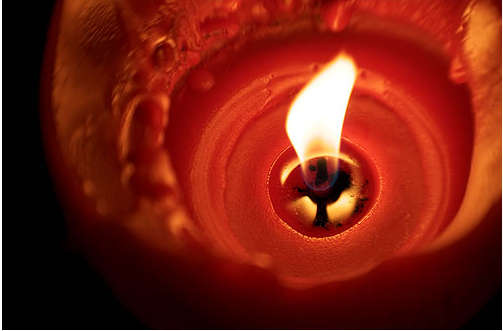FWP:
SETS
CANDLE: {39,1}
LIFE/DEATH: {7,2}
As the commentators say, this is a chillingly beautiful and grim verse, a classic formulation of the dilemma of human suffering. The first line poses the rhetorical question, who or what could cure the grief of life, except death? The way the line is phrased makes it impossible to decide whether death is the curer (who can cure life, except Death?) or the cure (what can cure life, except death?). Then the second line illustrates the ineluctability of the situation with a perfect example.
The example is the candle, which 'burns', or suffers (see the definition above), for as long as it is 'alive', or lit. No matter what, it goes on 'burning' (both literally and metaphorically) 'in every rang ' until morning. The versatility of rang here does excellent service: it literally means 'color', but thus by extension means 'mood', 'style', 'manner', etc. (see the definition above). Even as a its color and shape change, the flame continues helplessly to burn.
The candle burns until dawn. The white light of dawn is the signal for the colorful gathering to break up; it's the time when candles gutter to extinction. Finally the candle, now a small puddle of cold wax, is free from its 'burning', just as the human being can expect death to bring an end to suffering. Is this an image of despair? In a sense it is, but not entirely. The image of the lively 'warm' candle-lit intoxicated party that terminates in the cold deadness of dawn is one side of the coin (as in {169,12}). But the welcome arrival of the light of dawn to terminate a dark night of pain is the other side of the coin.
For an illustration of dawn as light and hope, consider the second verse in the whole divan: in {1,2}, making it through a black night of solitude and suffering until the hopeful white light of dawn is as difficult as Farhad's task of carving a channel through black stone to bring white milk. Or consider {169,1}: in the speaker's dark chamber, in the night of grief and oppression, the only proof of the coming of dawn [dalīl-e saḥar] is a single candle-- and that candle is, as it must then be, an extinguished, literally 'silent' [ḳhāmosh], one. (Mystically speaking, death can of course be seen as the dawn of a new day-- even a 'wedding day' [ʿurs].)
For another superbly deployed case study of these back-and-forth hope-and-despair metaphorical possibilities, see Mir: M{7,2}.
For life as a night of travel, with arrival at dawn, see {54,5x}.
On the possibilities of juz , see {101,1}.

Hali:
Both of Mirza’s divans, Urdu and Persian, are filled with this kind of novel and peerless similes.
==Urdu text: Yadgar-e Ghalib, p. 127